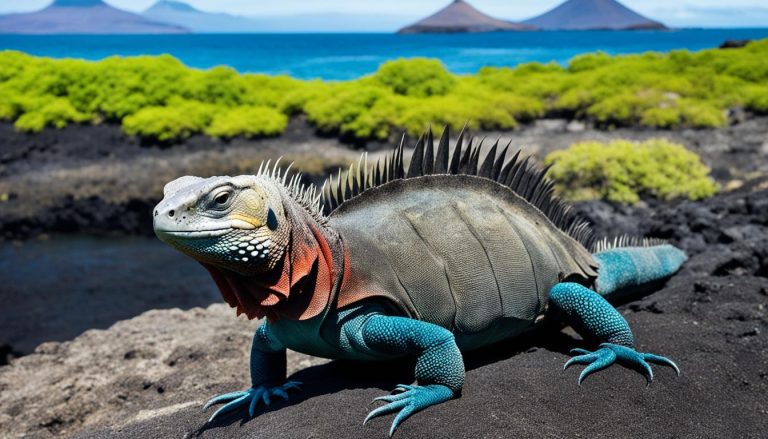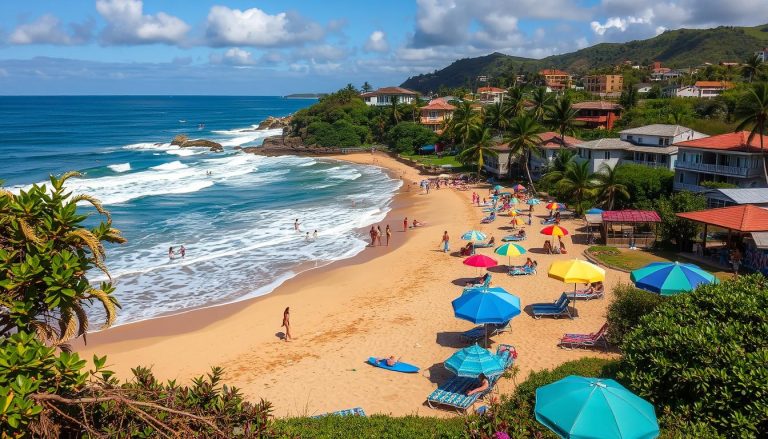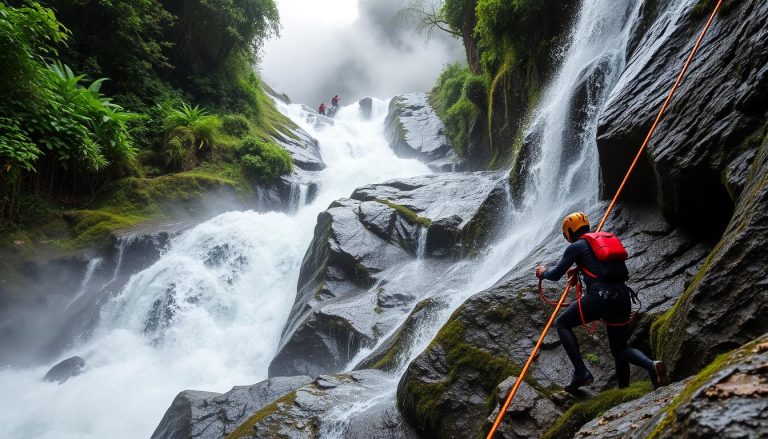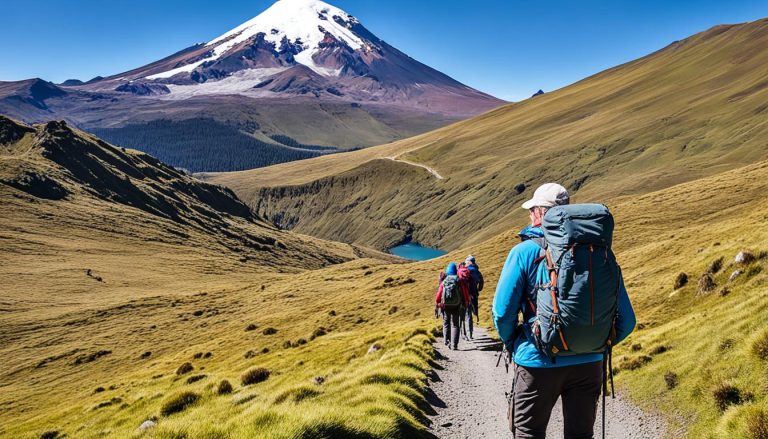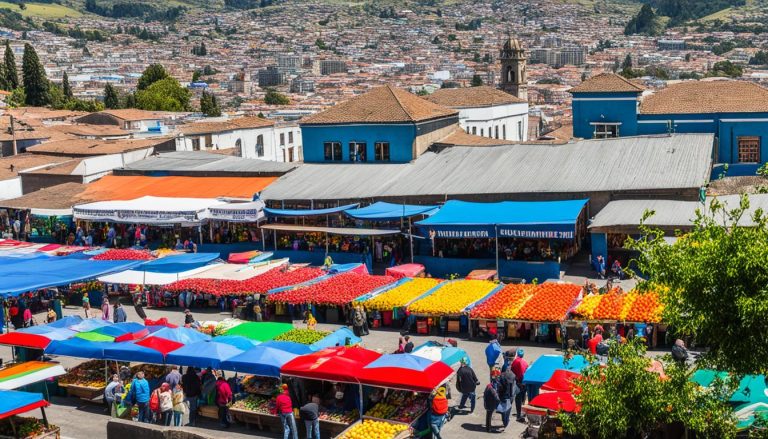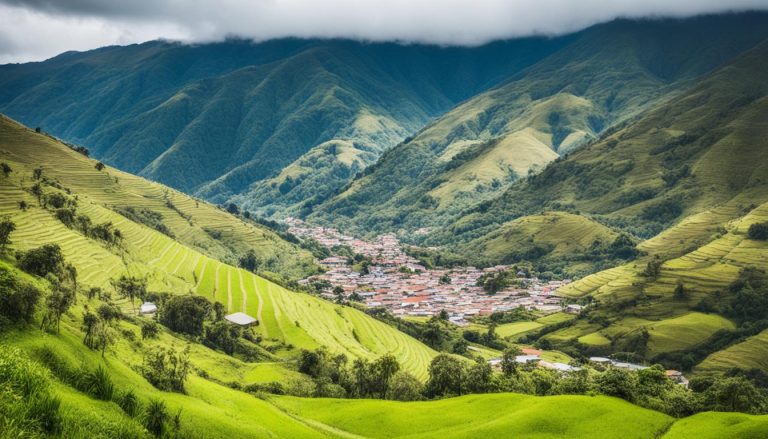Ever dreamed of standing on a high volcano, with the Andes stretching out before you? Welcome to Chimborazo National Park, a stunning place in Ecuador. It’s an amazing adventure spot. You can climb the tall Chimborazo volcano or learn about the culture of local communities.
This park is a true treasure that will amaze anyone who visits. It’s a place where nature and culture come together beautifully.
Key Takeaways
- Chimborazo National Park is home to the highest peak in Ecuador and one of the 20 highest summits globally.
- Explore a diverse range of hiking trails and mountaineering opportunities, including the chance to conquer the Chimborazo summit.
- Discover the park’s rich biodiversity, including endemic Andean wildlife and stunning glacial formations.
- Immerse yourself in the vibrant indigenous cultures that have thrived in this region for centuries.
- Enjoy a range of outdoor activities, from camping under the stars to capturing breathtaking landscape photography.
Chimborazo: Ecuador's Towering Volcanic Marvel
In the Andes, the Chimborazo volcano is a natural wonder of Ecuador. It’s a huge stratovolcano, towering at 6,310 meters (20,703 feet). It’s the highest peak in Ecuador and the closest to the sun.
Location and Access
Chimborazo is about 235 kilometers south of Quito, in the Chimborazo Wildlife Reserve. You can get there by bus from Quito to Riobamba. Then, take a bus or taxi to the park entrance.
The Allure of Chimborazo's Summit
Reaching the top of Chimborazo is a challenge for climbers. You can aim for the Veintimilla peak or the Cumbre Maxima. It’s key to get used to the altitude and prepare well.
Best Time to Visit and Climb
The dry season, from June to July and December to early January, is best for visiting Chimborazo. The weather is sunny and not too cold. But, it gets very cold at night and windy at high places.
Climbers should start early and return by 10 AM. This avoids dangers like rockfall and clouds.
“Chimborazo’s summit is a major draw for mountaineers and adventure seekers. At an impressive elevation of 6,310 meters (20,703 feet), Chimborazo is Ecuador’s highest peak and the closest point on Earth to the sun.”
Hiking and Mountaineering Adventures
Chimborazo National Park is a paradise for hikers and mountaineers. It offers trails for all skill levels. Whether you want a gentle walk or a tough climb, this volcanic wonder has it all.
Popular Hiking Trails
The North Side via Las Murallas Rojas and the North Side via El Castillo are great for beginners. They provide beautiful views without needing advanced climbing skills. The Original Route, first climbed in 1880, is a bit tougher but still doable with the right training.
For the experts, the West Face route is a challenge. It’s rated WI4 and requires top-notch ice climbing skills.
Guided Climbs and Expeditions
For a safe Chimborazo climb, consider joining a guided tour or expedition. These trips come with gear, guides, and transportation. Guides will help you adjust to the high altitude with hikes in the Andes before you reach the summit.
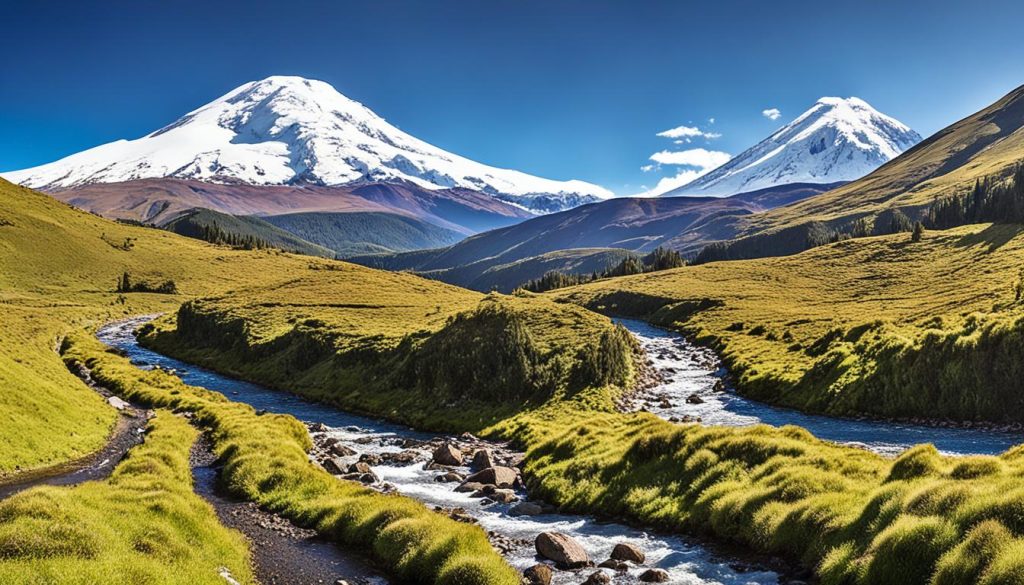
“Chimborazo, at 20,702 feet, is Ecuador’s highest peak and was first climbed in 1880.”
Exploring the Chimborazo Wildlife Reserve
Under the shadow of the towering Chimborazo volcano lies the Chimborazo Wildlife Reserve. It’s a paradise for those who love nature. Here, you’ll find a variety of unique animals and plants. The reserve is especially famous for its vicuñas, smaller cousins of llamas and alpacas, prized for their soft wool.
Endemic Species and Biodiversity
The reserve is home to many unique animals of the Andes. You might see a vicuña, the Andean condor, or the Andean fox. Its different habitats like grasslands and high-altitude forests support a wide variety of plants and animals. This makes it a hotspot for biodiversity.
| Endemic Species | Description |
|---|---|
| Vicuña | A smaller relative of the llama and alpaca, known for its incredibly soft and lightweight wool. |
| Andean Condor | The national bird of Ecuador, with a wingspan that can reach up to 3 meters (10 feet). |
| Andean Fox | A small, medium-sized fox found in the high-altitude regions of the Andes. |
The Chimborazo Wildlife Reserve is a paradise for nature lovers. It lets visitors see diverse ecosystems and meet the area’s unique animals. Whether you love birds, wildlife, or just nature, this place is a must-see in Ecuador’s Chimborazo region.
Indigenous Culture and Local Communities
Chimborazo National Park is more than just nature. It’s a place where indigenous culture and community thrive. Visitors can dive into the traditions of the Andean people. They have a strong bond with the land and its resources.
Exploring the area’s indigenous communities is a unique experience. You can join in local festivals and learn about traditional crafts. This can be a truly enriching and eye-opening journey.
The culture of Chimborazo is deeply rooted in Andean traditions. These traditions include vibrant textiles and the use of native herbs. The local people show a rich cultural heritage. Visitors can meet the indigenous people, learn about their customs, and appreciate their way of life.
Attending local festivals is a highlight of visiting Chimborazo. These events feature traditional music, dances, and ceremonies. They give a peek into the spiritual and communal life of the Andean culture. Visitors can enjoy the vibrant colors, rhythmic beats, and the energy of these celebrations.
The local communities in Chimborazo are also key to the park’s preservation. They depend on the land for their livelihood. They work with park authorities to protect the environment and support their communities.
By engaging with the indigenous culture and local communities, visitors help preserve Chimborazo’s cultural heritage and natural wonders. This makes their visit meaningful and contributes to the region’s future.

Scenic Landscapes and Natural Wonders
Chimborazo National Park is a true gem in Ecuador’s Andean landscapes. It shows off some of the country’s most stunning natural scenes. Visitors see the towering, ice-capped Chimborazo volcano and the dramatic glaciers and volcanic formations.
Glaciers and Volcanic Formations
The park’s glaciers are a sight to behold. They are massive ice formations on the slopes of Chimborazo. They inspire a sense of wonder in all who see them.
The park also has many volcanic formations. These include towering rock walls, craggy peaks, and unique geological features. These formations tell the story of the region’s fiery past.
Stunning Viewpoints and Photography
Chimborazo National Park is a dream for photographers. It offers endless chances to capture the region’s beauty. From the snow-capped summit of Chimborazo to the serene glacial lakes, there are perfect spots for photos.
Whether you’re a pro or just love taking pictures, Chimborazo will give you unforgettable shots. It’s a place that leaves photographers with amazing images.
“Chimborazo National Park is a true feast for the senses, with its awe-inspiring glaciers, volcanic formations, and breathtaking vistas that will leave you in a state of pure wonder.”
Camping and Outdoor Activities
Chimborazo National Park in Ecuador is a dream spot for those who love the outdoors. It offers more than just hiking and climbing. You can enjoy a peaceful camping trip under the stars or a thrilling adventure in the Andes.
The park has many trails for exploring. You can take easy walks or challenging hikes. Along the way, you might see the famous Andean condor.
Camping here lets you connect with nature. You can set up your tent in special spots and listen to the Andean wind at night. Wake up to stunning views of high peaks and glaciers. Then, start your day with a hearty breakfast before your next adventure.
There’s more to do than just hiking and camping. You can go birdwatching to see unique birds. Or, try wildlife viewing to see animals like the Andean bear or puma.
For a memorable experience, think about going on a guided tour. These tours show you the park’s beauty and teach you about local culture.
Chimborazo National Park is perfect for anyone looking for a calm retreat or an exciting adventure. It’s a top spot for outdoor lovers in the Ecuadorian Andes.
Chimborazo National Park, Ecuador: Best Things to Do - Top Picks
Chimborazo National Park sits in the heart of the Ecuadorian Andes. It’s a place that captures the hearts of visitors with its tall volcanoes, diverse wildlife, and deep culture. It’s perfect for those who love adventure or nature.
The park is home to the famous Chimborazo volcano, the tallest mountain in Ecuador. It stands at 6,268 meters (20,564 feet) high. Climbing this volcano is a big challenge for experienced climbers. But, there are trails for everyone, from easy walks to tough hikes.
- Explore the park’s diverse hiking trails, from gentle strolls to challenging treks, each offering stunning vistas of the Andes mountains and glimpses of the park’s endemic species.
- Join a guided expedition to scale the mighty Chimborazo volcano, a once-in-a-lifetime opportunity to conquer one of Ecuador’s most iconic natural wonders.
- Immerse yourself in the vibrant indigenous communities that call Chimborazo home, learning about their traditions, crafts, and way of life.
- Marvel at the park’s natural wonders, from the otherworldly glacial formations to the lush, high-altitude grasslands teeming with wildlife.
- Capture breathtaking photographs of the park’s stunning landscapes and diverse flora and fauna.
| Top Things to Do | Chimborazo Experiences | Chimborazo Activities |
|---|---|---|
| Hike to the Chimborazo summit | Immerse in indigenous culture | Guided mountaineering expeditions |
| Explore the Chimborazo Wildlife Reserve | Marvel at glacial formations | Wildlife spotting and birdwatching |
| Photograph the park’s stunning landscapes | Capture breathtaking views | Hiking and trekking |
Chimborazo National Park is perfect for those seeking adventure or peace. It offers unforgettable experiences. Discover the best things to do and enjoy the beauty of this Andean gem.
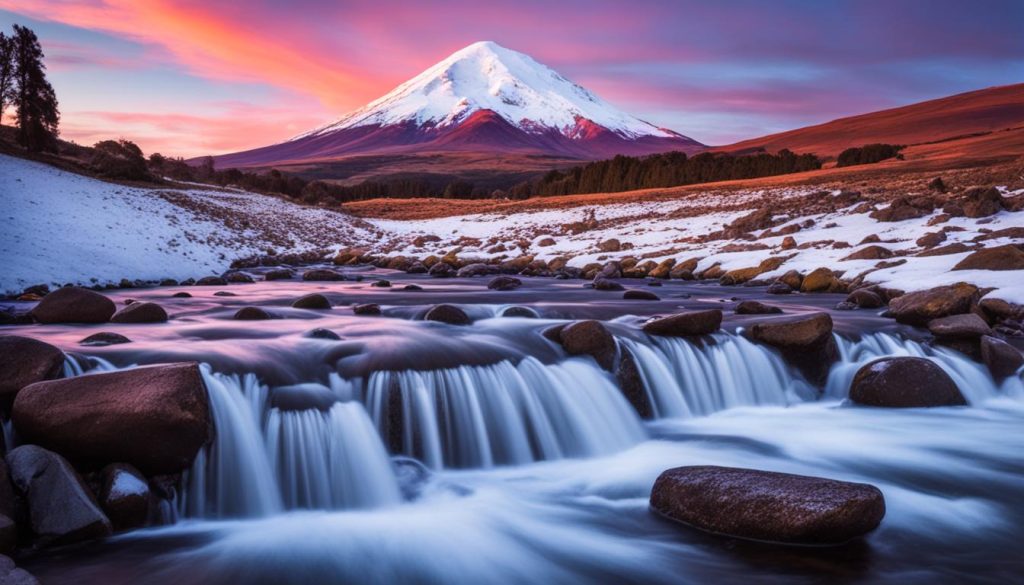
“Chimborazo is not just a mountain, it’s a symbol of the Andes, a testament to the raw power of nature, and a gateway to understanding the rich cultural heritage of Ecuador.”
Planning Your Visit to Chimborazo
Chimborazo National Park in Ecuador is a must-see for adventurers. It’s key to plan your trip well to enjoy it fully. The best time to go is from June to July and December to early January, when it’s dry.
Best Time to Visit
The dry season, from June to July and December to early January, offers great weather. You’ll have sunny days and comfy temperatures, perfect for outdoor fun. But, remember, it gets cold at night and windy at high places. So, pack right for your trip.
Guided Tours and Packages
For an easy and safe trip, consider guided tours and packages. These include transport and mountaineering guides for hiking and climbing. You’ll get to explore with experts and enjoy a worry-free adventure.
Planning your visit right can make your trip amazing. Choose the best time to visit Chimborazo and go with Chimborazo guided tours and packages. You’ll have an unforgettable time in this beautiful part of Ecuador.
Nearby Attractions and Side Trips
Chimborazo National Park is a big draw, but the Andean region has more to offer. You can find nearby attractions and side trip options. These include the beautiful Andes attractions and natural wonders.
Don’t miss the Quilotoa Volcano, a caldera lake in the Andes. It offers stunning views and hiking trails around the crater. Another spot is Cotopaxi National Park, with the famous Cotopaxi Volcano, one of the tallest active volcanoes.
For a city visit, head to Quito, Ecuador’s capital. It’s full of culture, history, and great food. The city’s colonial center is a UNESCO World Heritage Site, a key side trip from Chimborazo.
Looking for volcanoes, culture, or colonial towns? The Andes attractions near Chimborazo are perfect for your trip. They let you experience the best of Ecuador’s remarkable region.

Responsible Tourism and Sustainability
Chimborazo National Park is a protected area that focuses on responsible tourism and sustainable practices. Visitors are asked to follow Leave No Trace principles. This means they should reduce their impact on the environment and support local communities and conservation efforts. By choosing eco-tourism and responsible exploration, travelers help protect the park’s ecosystems and cultures for the future.
At Chimborazo, responsible tourism is a big deal. It teaches visitors to respect the environment, not litter, and stay on trails. Local guides and rangers help by encouraging good behavior. This keeps the park’s beauty and culture safe.
- Support local communities by buying crafts, eating at local places, and joining community tourism projects.
- Lower your carbon footprint by choosing green transport like hiking or public transport when you can.
- Respect local customs and traditions, and be careful how you interact with indigenous communities.
Chimborazo National Park also has many sustainable practices. These include waste management, renewable energy, and protecting habitats. Visitors can help by throwing away trash properly, using reusable water bottles, and saving water and energy.
“Responsible travel is not just about reducing your impact, but also about enriching the lives of the local people and preserving the natural wonders that make a destination so special.” – Eco-tourism expert, Jane Doe
By following eco-tourism principles, visitors help make sure Chimborazo stays beautiful and rich in biodiversity. We can all work together to make sure tourism and conservation go hand-in-hand. This way, Chimborazo’s unique beauty and life will be here for future generations.
Conclusion
Chimborazo National Park in Ecuador is a true gem of the Andes. It offers natural and cultural wonders for you to explore. You can climb the iconic Chimborazo volcano or dive into indigenous traditions.
The park’s stunning landscapes make it an unforgettable Andean adventure. It’s perfect for mountaineers, nature lovers, or anyone wanting an enriching experience. Chimborazo National Park shows off the best of Ecuador’s Andes.
When planning your trip, think about responsible tourism and sustainability. Your visit should help protect this natural and cultural treasure. With careful planning and a spirit of exploration, you’ll make memories that last a lifetime.

